 This week I’ll be visiting the classrooms of Antony Flackett at Massachusetts College of Art & Design, and Wayne Marshall at Harvard/Brandeis. Flackett (DJ Flack) is teaching a course called Beat Reseach: Music Art and Culture in the Age of Hip-Hop, while Marshall (Wayne&Wax) is doing one called Electronic Music: History and Aesthetics of Popular Music Since the 1960s. And yes, they’re also both resident rhythm-professors at the weekly Beat Research party which I’ll be spinning some tunes at this Monday.
This week I’ll be visiting the classrooms of Antony Flackett at Massachusetts College of Art & Design, and Wayne Marshall at Harvard/Brandeis. Flackett (DJ Flack) is teaching a course called Beat Reseach: Music Art and Culture in the Age of Hip-Hop, while Marshall (Wayne&Wax) is doing one called Electronic Music: History and Aesthetics of Popular Music Since the 1960s. And yes, they’re also both resident rhythm-professors at the weekly Beat Research party which I’ll be spinning some tunes at this Monday.
This week Wayne’s class will be touching on Hardcore/Breakbeat, Ragga/Jungle, Drum’n’Bass, Garage/2step, and Grime/Dubstep and the production project for the students is to “create a track in either Hardcore, Ragga/Jungle, Drum’n’Bass, Garage, Grime or Dubstep style.” If there’s one thing all these styles have in common, it’s BASS; often a kind that I like to call “wub-bass” because of it’s wub-wub-wub-wub sound.
In the early ’90s, rave-music producers began focusing on basslines as a point of timbrel innovation. By the late ’90s drum’n’bass often had bass sounds like nothing anyone had heard before. That innovation could also be found in the development of garage/2step, and is still alive and well in dubstep, electro-house, and even some commercial hip-hop and dancehall.
I thought I would take this opportunity to present the following.
Tutorial: Create A Dubstep-Style Bassline
Here’s a short track I worked up for this demonstration:
[audio:uggc://znfuvg.pbz/nhqvb/Onff%20Ghgbevny%20Shyy%20Genpx.zc3]Download: Full Track
This track only consists of two parts: the beat and the bassline. I started by making the beat which you can listen to below, but for the purposes of this tutorial I’m not going to go into how I made it:
[audio:uggc://znfuvg.pbz/nhqvb/Onff%20Ghgbevny%20Orng.zc3]Download: Beat
What we’re really looking at here is the bass; synthesizer-bass in particular. I used the Subtractor synthesizer in Propellerhead Reason for this tutorial because it’s relatively simple and has the same features that you’d find on almost any synth, including old analog ones.
The bassline — made up of 3 parts — is created by using 3 separate Subtractor synth modules. Here’s the first part:
[audio:uggc://znfuvg.pbz/nhqvb/Flagu%20Onff%201.zc3]Download: Synth-Bass-1
Here’s how I made it:
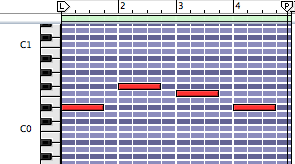
The picture above a is simple four measure sequence of four notes that make up the bassline. For those not familiar with Reason’s sequencer, those piano keys on the left side will give you an idea of what’s going on. But the audio file above sounds like more than just four sustained notes, right? That’s due to the magic of low frequency oscillators (LFO). Let me explain.
I begin by setting a sound generating oscilator (“Osc 1”) to a square wave (Click the images below to see them full size):
I also set a second oscillator to a square wave, but on this one I set the semitone off a few cents (-22 “Cent”), and then mix the two oscillator sounds together (see the “Mix” knob). This creates a slightly out of phase, rougher sound:
Up to this point you’d be hearing four sustained notes playing in sequence. Here’s where the LFO comes in. I activate “LFO 1” by turning up the “Amount” knob. I turn on the “Sync” button which synchronizes the rate of the oscillation to the tempo of the sequence (the beat). By turning the “Rate” knob I can change how fast the oscillation goes. I then set the LFO to control “F. Freq” (filter frequency). I’ll explain that further below, but in a nutshell, this is how you achieve the wub-wub-wub-wub sound on a note that would normally be sustained.
I set the LFO to control the “Freq” slider on “Filter 1”. The filter controls what frequencies from the oscillator pass through. I have it set to “LP” (low pass) which only lets the lowest (bassiest) frequencies pass through. Depending on the “Amount” of LFO one sends to control the “Freq” one hears more or less of the frequencies that are being filtered out, creating the rhythmic, wub-wub-wub-type sound.
That was fun, but I want more BASS. This sound contains some bass but it also has a lot of higher frequency information. I want to make sure that this bassline will rattle peoples eyeballs when it’s played in the club so I added a second synth that’s playing the same notes as the first, but the sound is a straight sub-bass tone:
[audio:uggc://znfuvg.pbz/nhqvb/Flagu%20Fho%20Onff.zc3]Download: Sub-Bass
You probably can’t hear that unless you have serious speakers or headphones. It’s very low. This new synth uses a sine wave which is cleaner sounding than a square wave, and no LFO, making for a pure, sustained bass tone.
OK, that part’s easy. Now for the third synth; the one that sounds like this:
[audio:uggc://znfuvg.pbz/nhqvb/Flagu%20Onff%202.zc3]Download: Synth-Bass-2
This synth is very similar to the first one except that I detuned the pitch of “Osc 2” a bit differently; 29 “Cent” this time:
Again, this synth is playing the exact same notes as the other two. The main difference here is the LFO. I have it set to a different rate. It’s faster and I have a higher “Amount” of LFO as well:
The other difference is in the way I have the “Filter Envelope” set. On the first synth I had it set so that the longer the note is held, the more the the low pass filter opens. On this synth I have it set so that the longer the note is held, the more the filter closes. The “A D S R” you see below the sliders of the “Filter Envelope” represent Attack, Decay, Sustain and Release. On this synth I have the sustain all the way down and the decay most of the way down, so that the envelope brings the filter frequency down over time.
When you put these three synths together they appear to be one complex and super-bassy sound because they’re all playing the same notes.Here, give them a listen again:this synth:
[audio:uggc://znfuvg.pbz/nhqvb/Flagu%20Onff%201.zc3]Download: Synth-Bass-1
+ this sub-bass synth:
[audio:uggc://znfuvg.pbz/nhqvb/Flagu%20Fho%20Onff.zc3]Download: Sub-Bass
+ this synth:
[audio:uggc://znfuvg.pbz/nhqvb/Flagu%20Onff%202.zc3]Download: Synth-Bass-2
+ the beat:
[audio:uggc://znfuvg.pbz/nhqvb/Onff%20Ghgbevny%20Orng.zc3]Download: Beat
= the final track:
[audio:uggc://znfuvg.pbz/nhqvb/Onff%20Ghgbevny%20Shyy%20Genpx.zc3]Download: Full Track
That’s it for now. Happy bass-making.

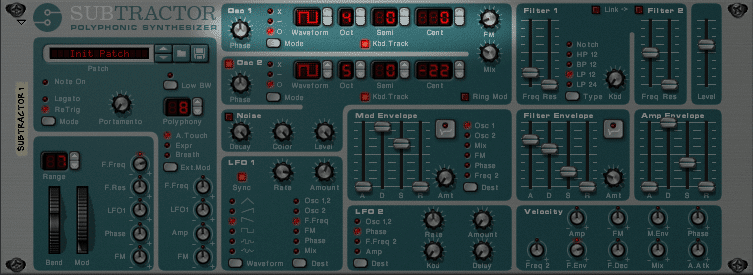
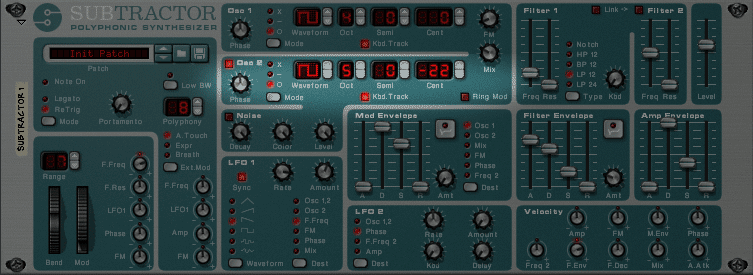
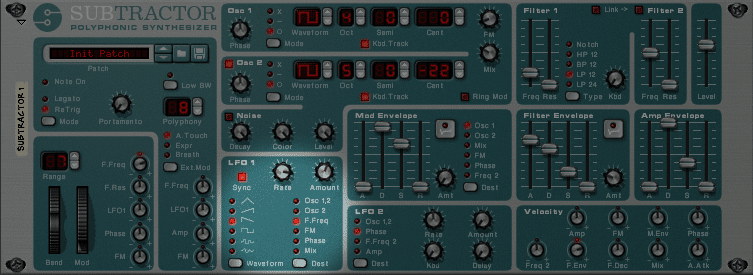
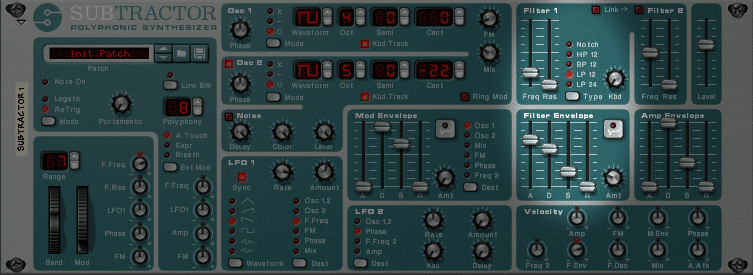
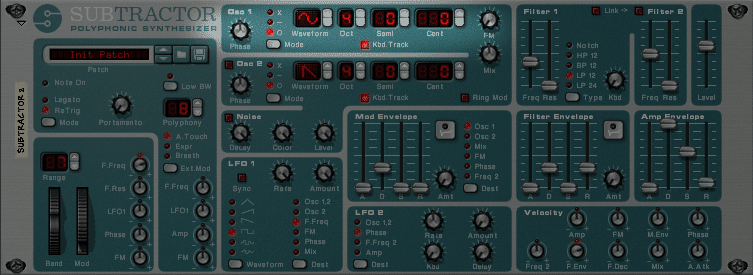
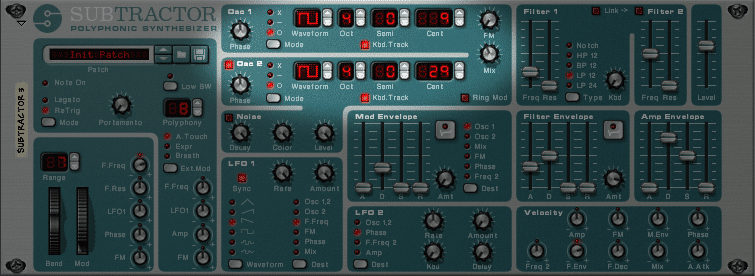
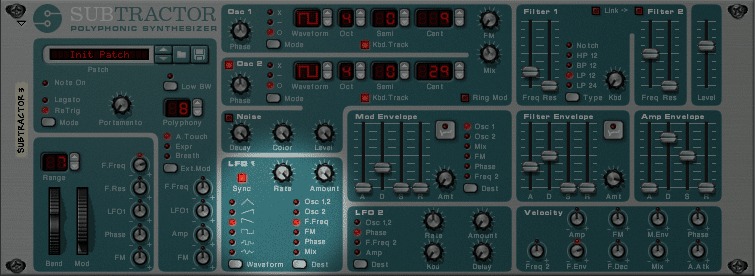
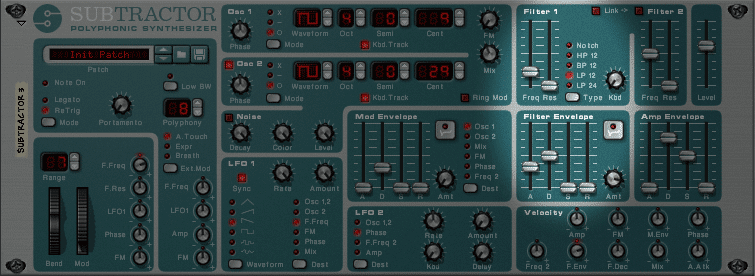
Cool tutorial, would be even better if the samples were mp3s not flash or whatever
this is siiick. keep it up!
Thanks for the feedback. I added the MP3 links so now you can listen in the browser and/or grab the files.
PS: Anyone know of good, free screencasting software for the Mac? This tutorial might be more informative w. video.
This is great!
I’ve seen great screencasts made with iShowU: http://www.shinywhitebox.com/
very nice — you guys should make this a regular thing
MUSIC MAGIC
Knowledge & Wisdom, nice to see and hear, Thanks
wow, thanks so much for this!
great stuff… i always wondered what LFO was all about.
the best part is how much your ‘dubstep by numbers’ sounds like so much of the stuff which is actually getting pressed to vinyl over here. leading me to realise that it is, in fact, dubstep by numbers!
spread the WUB love DJ C!
…nice shirt…
I think you mean the sub-bass synth is a “sine” wave.
You’re right, Anon. Fixed!
Thanks for the Shiny White Box info, Tones. That looks great.
Actually, I think that the “demo” track came out pretty dope, or at least could be a promising start toward something a little more Mashity.
But I think Gervase also affirms here a point I tried to make on my blog (trackback below): no one should fear sharing such “secrets,” for it still takes something special, and something deeply personal and idiosyncratic, to make distinctive music. Everyone and they moms could know how to work up a wubbity wubbity, but not everyone can use one to propel a BIG CHUNE.
Bravo, Mr.Mashit! More like these, please —
And yeah, video woulda sweet! There’re all kinds of great beat-making how-to’s on YouTube already, but I could see a Mashit channel being in a class of its own.
I wub this post
woowoowoowoowoowooowoowo
i knew the lfo on the filter trick- but walking through the way you approach layering is very nice. lfo at diff rates on different detuned basslines is something i’m going to have to try soon…
peace! more like this please!
-g
nice one
love this regular please !! and maybe using free vsts or something more usabale for every system as cubase
Yes! More more more!
you’ve nailed the ‘wub wub’…while you’re at it, how about serving up similar exposes of the ‘reece’ and the ‘jetplane’?!?!
You yanks no nothing about dubstep. Leave it for the UK producers.
Yeah love the tutorial good!
I just found this, but it is amazing. Thank you so much for this. For all of those that don’t have/use reason, may I suggest Automat as a free alternative. Everything that C covered in this is doable in Automat. I do have one question, though. What if you want the LFO envelope to shift not over the course of one note, but over the course of a bar. Is this possible? My one thought was going to be to record the shifts as one note and then repitch the parts in Ableton, but I am not sure how that will work out. Any help would be much appreciated.
Thank you for this. I found it very helpful
Hello,
I can’t seem to be able to get this to work after a few hours… arg… I soooo much want to wobble I sooo much want to do this I run logic I do not have reason My roomate does but I have no idear how to use it. Help! Please link any other resources or send em to me.
Sexface, I would probably use “automation” in Ableton to achieve modulations over the course of longer time periods. You can draw in lines in the automation channels to modulate just about any parameter of any effect, volume, pitch, panning etc, over the course of as much time as you’d like.
Help Me Wobble, I haven’t used the synths in Logic in quite some time, but they should have the standard LFO modulation abilities. The ES1 for example (see picture here) has an LFO on the bottom left which you can assign to many of the parameters of the synth, including filter, pitch, or amplitude. It can be synced to the tempo or not. That should help you get the wobble.
its not a secret but if you really ought to have figured it out on your own.
Amazing post! Thanks!! I’ve been trying to figure this stuff out for months! One question, could you recommend a vst synth (usable in Ableton) that has a similar interface to the one in the tutorial? I have a million of them but none are laid out simply enough for me to duplicate what you did….. greatly appreciated
nice one guys.
i like this element of openness, reminds me of the invizbl skratch piklz ethos “we’ll show you how to do what we do, cos we want you to come back with something even better”. by doing so they helped a bunch of djs raise the bar… and they still stood at the top.
i don’t understand why some people ‘guard’ their methods – if something is easily replaced by a paint-by-numbers replica, then it wasn’t that special to begin with.
big props to my beat researchin’ bretheren.. miss you guys.
wicked tutorial. well explained. cheers
Thank you
Positive Vibration Rules the Nation
Peace, love, and Bass Happiness
That’s a good tutorial.
I’d like to mention by asigning LFO to pitch with a really slow rate is a good way to get that classic “dive bomb” bass sound as used in a lot of dubstep/drum & bass tracks. I’m all for sharing the knowledge.
Azzer: I’d suggest get your hands on rob papen’s blue or albino synths. Seriously powerful with lots of LFO routing options. The interfaces are not straight forward but just read the manuals and I’m sure you’ll get some decent results.
filth mate pure filth lovin the tambourine on the drums
Awesome turorial!
Any1 know a good free vst that can make sine waves? My minimonsta can handle all the other stuff but it can’t make sine waves…
dopealisious!
Thanks for the tutorial. I’m using Garageband, got the gist of the lesson though. I selected the Future Flute (quite garage-ish sound) Riffy Fifths, and a Sine Wave for Subs. I found if you bump up the sustain on the synths the LFO effect works better. For the LFO I’m using the Autofilter and manual setting it to how I like the sound.
Awesome tutorial thanks.
Nice man, nice
amazing stuff man. i need this! gonna try is tomorow!
So legit. I’ve using the Subtractor for a while now and I had a feeling it’d be the way to go for the wub bass. You’ve illustrated the concept very clearly and now I’m on my way to making my first dub step track. Many thanks!
You rock. Many thanks for taking the time to drill down and go into all the details!
Hey man! Don’t know if it’s too much, but, would be cool have the subtractor patches too! Maybe the RPS!? : ) But anyway! Thanks. Kinda cool see what other are doing too…
“r1chod
Dec 21st, 2007 at 11:57 am
You yanks no nothing about dubstep. Leave it for the UK producers.”
Fool, the Yank ArtWork practically invented the damn stuff. Go educate yourself…
Wow this was some great info. Thanks
Why the hell is the tutorial in SOFTWARE?
I want to know what hardware is suitable for the bass, if evryone makes DubStep in Reason, were not going to have lots of variation to it right?
Hello,
Reason is an incredibly flexible piece of software. I chose to use its Subtractor synth because it’s very similar to many classic analog (and digital) hardware synths.
Starting with a wave form oscillation and then applying filtering, LFO, etc. is basic synthesis, weather it’s software or hardware. If you prefer to use hardware you can apply these same principles.
Just like most hardware synths, Reason can also be used to generate innovative new sounds if you get creative. I’m sure many dubstep producers, who’s basslines sound quite different from each other’s, use it in their arsenal.
WONK WUB WONK thanksXinfinity
Not bad at all, all i can say is that the hats and other drum elements need to be a bit less rigid. You need to keep them loose and in odd timings creating weird rhythms.
Agreed, Luke. Swing is really important. This was just for demonstration purposes, and with a focus on bass.
It’s actually interesting that you point that out as there’s been a “swing” back to more syncopated beats in dubstep after a period of a more rigid sound a while back.
The loss of interesting beats, and syncopation as jungle became drum n bass in the late ’90s was disappointing. I’m glad to see dubstep is staving off the stagnation.
wow… thanks for this, really helped me get a distinguished bassline, as alot of the dubstep i’ve done has sounded like it is missing something, sometimes you find it’s not neccesarily the sounds your ear first picks up, but the deeper sounds within that make a track…!! thanks sooo much!
wonderful walk-through. best tut of the week for sure. great point too re: the return of swing counts to current rhythm trends.
Thanx for the lesson:) And never a truer word spoken mad ep
Mint man, thank you very much, That’s where my problem lay, the sub bass was being LFO’d too, no wonder it didn’t sound right. I swear I thought I was good at this music thing til I saw this, very basic very intuitive tutorial, – and by Joe there is a lot to know!
regards
i’m a simpleton and couldn’t get my head round sequencing in reason so have put this into practice using fruityloops (shut up it’s easy, i know it’s not as good) but was really pleased nice easy to follow steps i’ve then just copied the settings of the main wub-wub synth and changed the lfo rate on it then used the 2 channels so that only one is playing at a time but use them like they are one instrument and it sounds like the speed of the wubs is constantly changing as if i was turning a speed dial while playing. i sure there’s a simpler way where u record while literally turning the dial but this works for me. cheerz
great tutorial, thanks for this!
I WUB WOO! I was trying to achieve the Wub by using a single Subt. module. If you taught a class, I’d pay tuition. Hourly rate available for lessons? I’m based in Chi too. DS
Hey Don,
Thanks! I’m glad the tutorial was helpful. Ha ha! Yeah, maybe I should consider giving lessons.
def a good addition to what ive been learning. thx!
I want a skype-2-skype lesson DJ C! Hook it up.
Thanks for the tutorial, just stumbled on it
This is a great tutorial but what about re-sampling, freq-splitting (that is multiband dynamics), & effects processing on your different tracks (drums, synths etc.) .. it’s good to understand the basic aspects of synthesis, but really you can use ANY vst to achieve this- that is albino, massive, reason’s thor, ableton’s operator, FM8, or a million more freeware synths, but the outcome is still the same.. DAW independent, the real trick is what comes after creating a wicked patch, like more advanced synthesis & sound design techniques, re-sampling, and mastering.. still good beginner tut
I agree, $wyN3F!u. It’s all about getting creative. This is a beginner tutorial that breaks down a super-basic synthesis idea, which can be done with just about any synth. It’s up to each producer to develop their own more advanced techniques. You should write a tutorial on multi-band processing and what you can do with it. I’d love to read it.
Hey! Nice tutorial, I made it and I’ve learned a new simple way to make a kick-ass phaseing square wobblying bass! 😀 Many thanks!